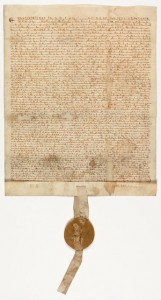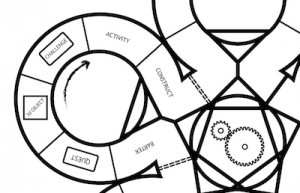Board of Rights and Responsibilities
Making a game of the Magna Carta
 Next year, the Magna Carta is 800 years old. As a seminal piece of human rights legislation it is arguably one of the most significant documents ever written. It describes the balance of rights and responsibilities between the English king and his lords (the closest it could get to ordinary people at the time!) Its influence persists today in both our courts and culture.
Next year, the Magna Carta is 800 years old. As a seminal piece of human rights legislation it is arguably one of the most significant documents ever written. It describes the balance of rights and responsibilities between the English king and his lords (the closest it could get to ordinary people at the time!) Its influence persists today in both our courts and culture.
Salisbury Cathedral is the only religious home to a surviving copy of the original document, reflecting the significant role the Church had in both the organisation and negotiation of the agreement.
Every year thousands of schoolchildren visit the cathedral to see the copy. To mark the anniversary next year, the cathedral is commissioning a new way of engaging youngsters with the principles enshrined in the document: a game.
I’ve been working with the excellent Education Team at the cathedral to think about how this new resource might materialise.
The challenge
The context of the cathedral presents some unique challenges to the game’s design. For a start, the game is to be situated inside the nave. To be played by a 30 strong class of 5 to 7-year-olds simultaneously. Obviously being fun but encouraging some thought about the balance of our own rights and responsibilities.
The approach
 This particular set of requirements more or less ruled out a digital solution. Although it is conceivable to erect a projector and screen within the building it is hardly the interactive play any class of children would enjoy. Likewise, whilst 30 individual devices is theoretically possible, the cost and management of such a solution makes it prohibitive (remember these are young children we are talking about and so they are unlikely to have smart phones of their own).
This particular set of requirements more or less ruled out a digital solution. Although it is conceivable to erect a projector and screen within the building it is hardly the interactive play any class of children would enjoy. Likewise, whilst 30 individual devices is theoretically possible, the cost and management of such a solution makes it prohibitive (remember these are young children we are talking about and so they are unlikely to have smart phones of their own).
Instead, we went Old School: a board game albeit one on a large scale.
In the circumstances, even a 10m x 10m board game has a number of advantages over more high-tech solutions. Most importantly perhaps, it is robust – capable of withstanding repeated pounding by groups of children. Secondly, a textile-based board and any game tokens can easily be rolled up and packed away when not in use.
 Educationally, the team at Salisbury were keen to tackle fairly sophisticated themes with the children. Without wanting to be bogged down with the historical intricacies of the Magna Carta, it was still important that children gained a sense of how negotiations work, the value of teamwork and the balance between individual rights and social responsibilities.
Educationally, the team at Salisbury were keen to tackle fairly sophisticated themes with the children. Without wanting to be bogged down with the historical intricacies of the Magna Carta, it was still important that children gained a sense of how negotiations work, the value of teamwork and the balance between individual rights and social responsibilities.
Ar med with these requirements, it was possible to work our way through the available game mechanics to identify the features that would work best for us. We needed a board game that was designed to reflect the interior of the mediaeval church, where small groups of children could work together to achieve their own goals and build something bigger together. The result is a game concept that takes the best parts of The Game of Life and Mousetrap and integrates the themes of the Magna Carta.
med with these requirements, it was possible to work our way through the available game mechanics to identify the features that would work best for us. We needed a board game that was designed to reflect the interior of the mediaeval church, where small groups of children could work together to achieve their own goals and build something bigger together. The result is a game concept that takes the best parts of The Game of Life and Mousetrap and integrates the themes of the Magna Carta.
Working through the cathedral’s ambitions for the activity, the constraints of the location and context and our set of game mechanics, we were able to propose a solution that will make a trip to Salisbury even more memorable. For the next 800 years?
